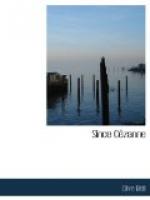Renoir never reminded anyone of Ravel or Laforgue. Renoir and Bonnard are not so much alike after all. In fact, both as artists and craftsmen they are extremely different. Renoir’s output was enormous; he painted with the vast ease of a lyrical giant. His selections and decisions were instinctive and immediate. He trusted his reactions implicitly. Also, there is nothing that could possibly be called whimsical, nothing critical or self-critical, about him. Bonnard, on the other hand, must be one of the most painstaking artists alive. He comes at beauty by tortuous ways, artful devices, and elaboration. He allows his vision to dawn on you by degrees: no one ever guesses at first sight how serious, how deliberately worked out his compositions are.
There is something Chinese about him; and he is one of those rare Europeans who have dealt in “imposed” rather than “built-up” design. Bonnard’s pictures grow not as trees; they float as water-lilies. European pictures, as a rule, spring upwards, masonry-wise, from their foundations; the design of a picture by Bonnard, like that of many Chinese pictures and Persian textiles, seems to have been laid on the canvas as one might lay cautiously on dry grass some infinitely precious figured gauze. Assuredly, the hand that lets fall these beauties is as unlike that which, even in the throes of rheumatism, affirmed with supreme confidence the mastery of Renoir, as the easy accessibility of our last old master is unlike this shy, fastidious spirit that M. Leon Werth, by a brilliant stroke of sympathetic intelligence, has contrived to catch and hold for an instant.
[Illustration: (Mrs. Jowitt’s Collection) DUNCAN GRANT]
DUNCAN GRANT
To-day, [N] when the Carfax Gallery opens its doors at No. 5 Bond Street, and invites the cultivated public to look at the paintings of Duncan Grant, that public will have a chance of discovering what has for some time been known to alert critics here and abroad—that at last we have in England a painter whom Europe may have to take seriously. Nothing of the sort has happened since the time of Constable; so naturally one is excited.
[Footnote N: February 6, 1920.]
If the public knows little of Duncan Grant the public is not to blame. During the fifteen years that he has been at work not once has he held “a one-man show,” while his sendings to periodic exhibitions have been rare and unobtrusive. To be sure, there is a picture by him in the Tate Gallery. But who ever thought of going there to look for a work of art? Besides, during the last few years the Tate, like most other places of the sort, has been given over to civil servants. Duncan Grant is a scrupulous, slow, and not particularly methodical worker. His output is small; and no sooner is a picture finished than it is carried off by one of those watchful amateurs who seem a good deal more eager to buy than he is to sell. Apparently he cares little for fame; so the public gets few opportunities of coming acquainted with his work.




